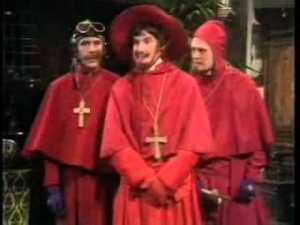It’s an odd experience to read a work of science fiction written before 1994 or so. These writers went to the wildest reaches of their imaginations to show us a vision of the future, and these visions included things like flying cars, nuclear apocalypse, nuclear-powered cars, robots as smart as humans (or even smarter), food pills, space aliens, and cheap and easy space travel. Then in the middle of it all, our hero picks up a newspaper made out of an actual piece of paper to find out what’s going on.
Nobody expected the Internet.

Image courtesy of YouTube.
Erm. Sorry. But it’s true that science fiction just didn’t see this one coming. So it’s refreshing to read something by a science fiction writer who had the slightest inkling. One such writer was Neal Stephenson, who’s most famous for his 1992 cyberpunk novel, Snow Crash. The characters of Snow Crash spend much of their time in a Metaverse that looks like the Internet. Sort of.
Stephenson imagined a fanciful place where people hardly ever use boring old keyboards and touchscreens. Instead you full-on VR into the Metaverse and walk around in a 3D-rendered street that represents all the places you can go. Never mind how frustrating it would be if you couldn’t instantaneously get to your e-mail when you want to see it, it’s cool.
Hiro Protagonist is a down-on-his-luck freelance computer programmer in real life, but in the Metaverse, he’s a katana-wielding warrior prince. When a virus starts going around that fries computer programmers’ brains if they so much as look at it, Hiro must find out who’s responsible and stop them.
That’s the plot, but the plot doesn’t really matter. Stephenson loves going for the outlandish imagery. Hiro’s sidekick is Y.T., a skateboard courier who wears a piece of personal protective equipment called a dentata (go on, guess). Corporations have taken over the world and the United States has been reduced to a patch of land near the LAX airport.* We’ve got a nuclear-bomb-toting Aleutian, wireless-radio-controlled zombies, and supersonic cyborg dogs.
The crazy part is that despite all of this gonzo, Stephenson’s Metaverse doesn’t go far enough. Check out this curious passage from near the beginning of the book:
In the real world – planet Earth, Reality – there are somewhere between six and ten billion people. At any given time, most of them are making mud bricks or field-stripping their AK-47s. Perhaps a billion of them have enough money to own a computer; these people have more money than all of the others put together. Of these billion potential computer owners, maybe a quarter of them actually bother to own computers, and a quarter of these have machines that are powerful enough to handle the Street protocol.
I bet you just meet tons of people who think, “Yeah, I could have Internet access, but why bother?”
Since the mid-1990s, the Internet has gutted the newspaper industry and revolutionized publishing and music. Television looks like it’s going to be next. I do all of my banking over the Internet, much of my shopping, and I call my parents and write to my coworkers over the Internet. President Obama won the election in 2008 largely because he was better at doing Internet than McCain. The United Nations has toyed with the idea that Internet access should be a human right.
Since Neal Stephenson is still very much alive, I hope he likes the brave new world he sees.
.
.
* It bugged me throughout the novel how this world could work without any functioning national governments. For starters, if we have a modern population density and no Center for Disease Control, would AIDS, tuberculosis, or Spanish flu finish these people off first?














